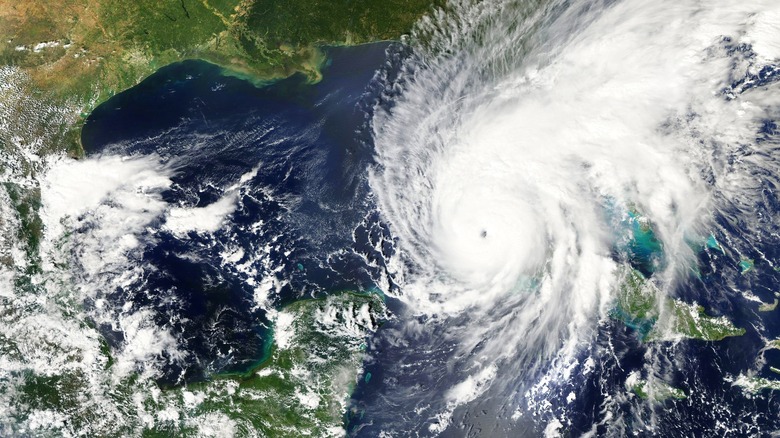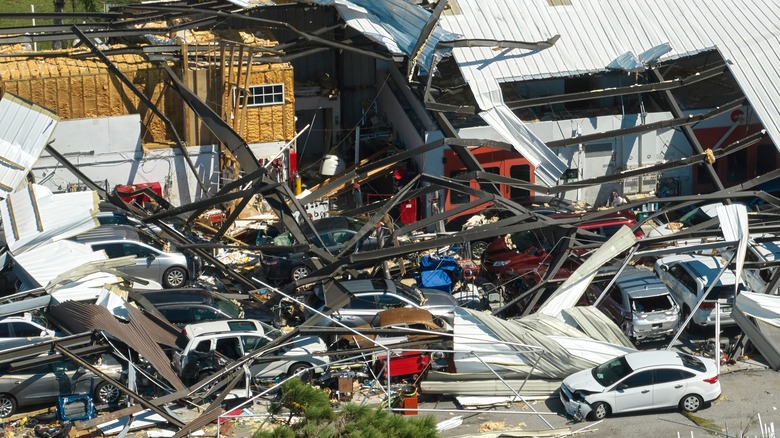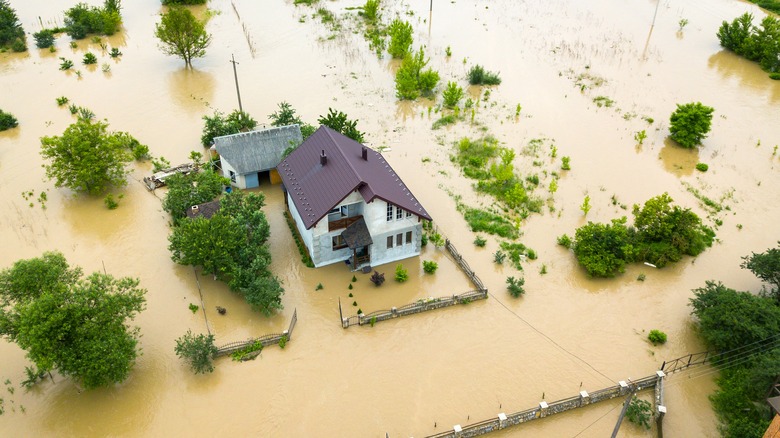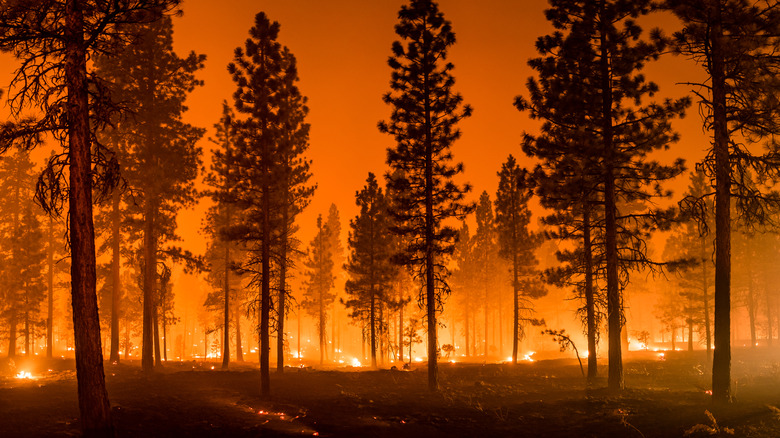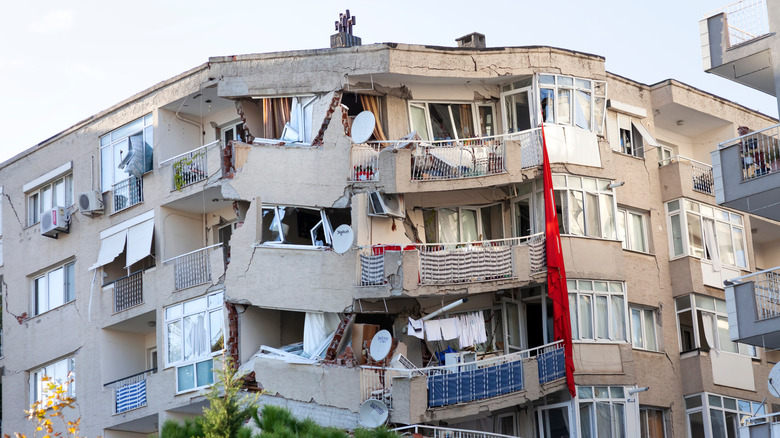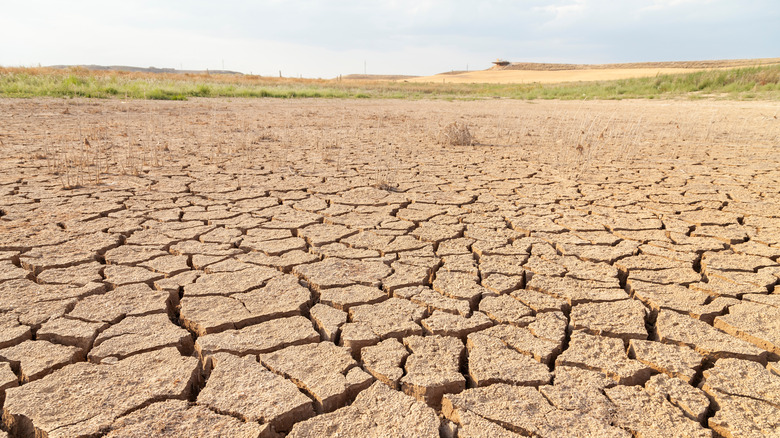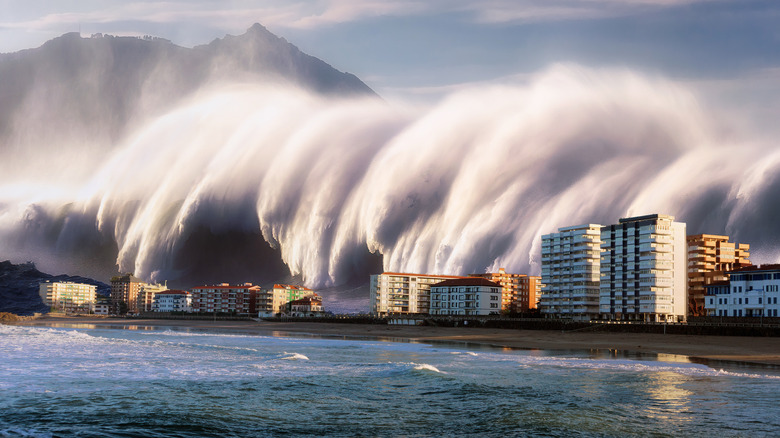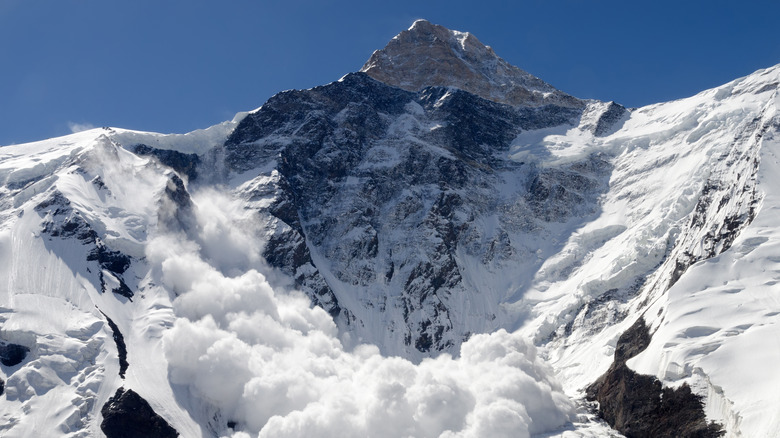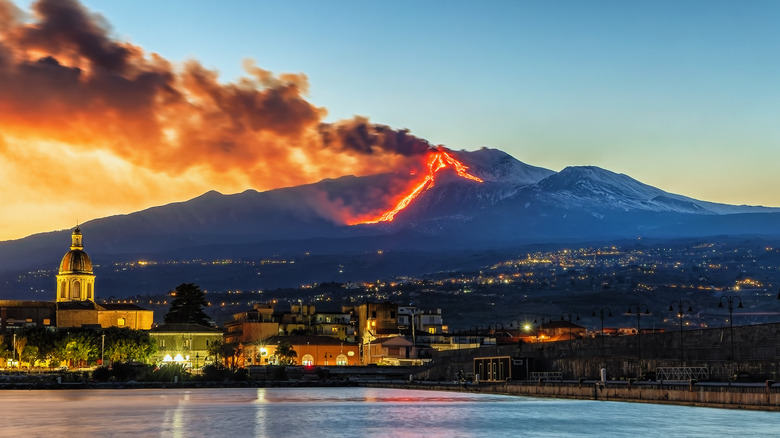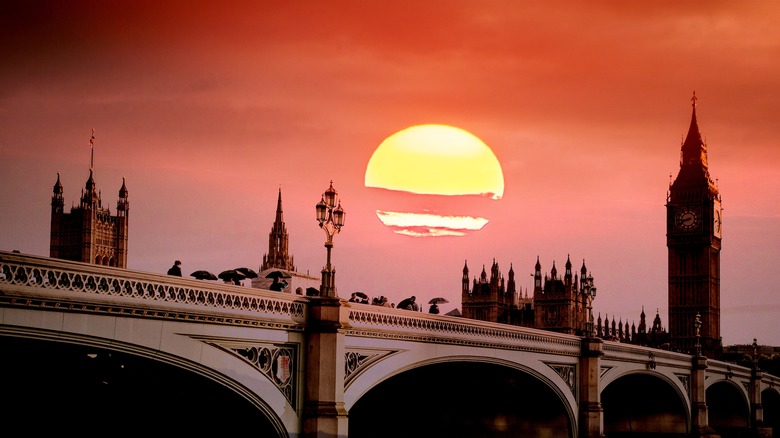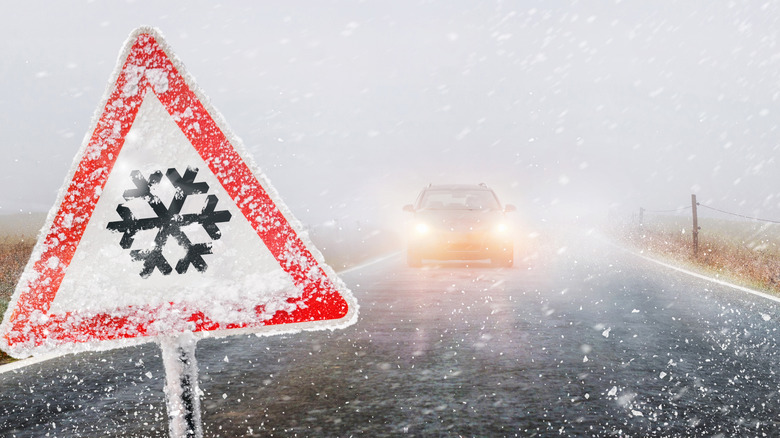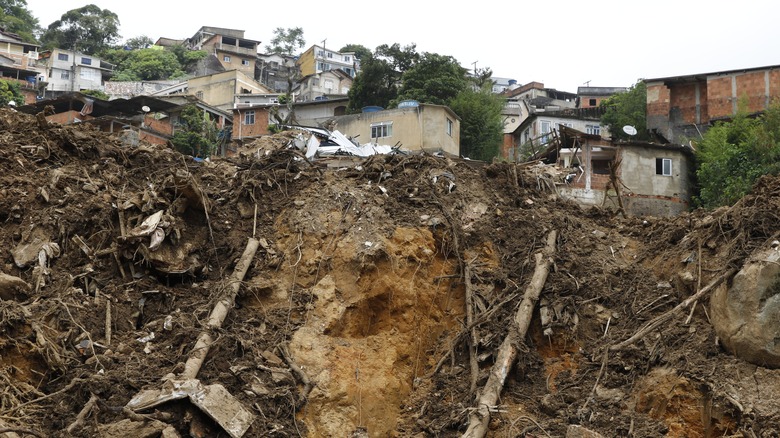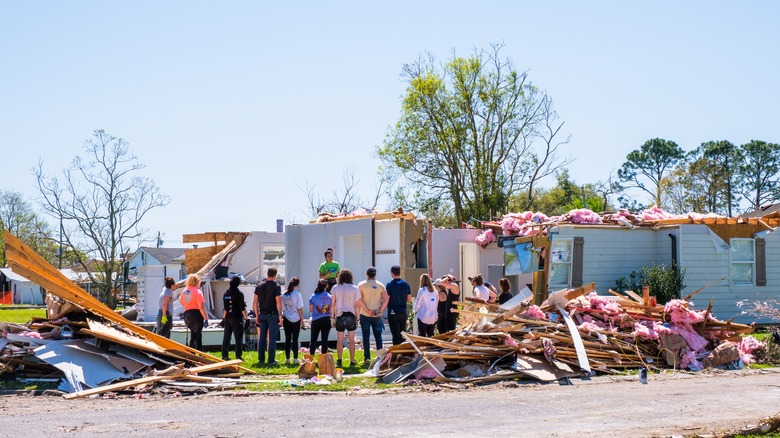How Different Natural Disasters Change The Environment
There are many movies that show a natural disaster at its worst: Perhaps big waves are crashing into buildings and people are running for their lives. But in reality, the aftermath of the disaster is just as difficult, as SWCA makes all too clear. Natural disasters are extremely powerful, whether they bring fire, water, wind, or snow. They not only threaten any life in their proximity, but they alter the environment, urban and natural alike.
And what better time to discuss natural disasters than today? As per Eos, we live in the age of the Anthropocene, defined by humans' unprecedented impact on our planet. This impact includes the menacing climate change, which, according to Zurich, has a lot to do with an increase in natural disasters. Increasing temperatures lead to more floods, wildfires, and hurricanes, which in turn change the environment as we know it. Oxfam paints a grim picture: Over the last three decades, the number of climate-related disasters has tripled, and managing disaster-related damages will cost developing countries $140 — 300 billion each year by 2030.
But as governments and NGOs (like the WWF) work hard to tackle climate change and ensure quick recoveries after natural disasters, we're reminded there's hope. And hope usually starts with awareness. So here's how different natural disasters change the environment.
Hurricanes
As per National Geographic, hurricanes are tropical storms that form in the Atlantic Ocean — in other parts of the world, they're called cyclones or typhoons. These storms are accompanied by a very violent kind of wind, blowing at over 74 miles per hour. This is why, as SWCA reports, hurricanes account for over two-thirds of property loss in the United States. But this isn't the only way hurricanes affect the environment.
Of course, hurricanes bring a lot of water with them, and this causes major floods that impact humans and animals alike. While humans can lose their houses, cars, or at least the power to their homes and various valuables, animals can lose their lives or their entire territory. Needless to say, endangered species are the most vulnerable. There's another aspect to hurricane-related floods: If sewage treatment facilities flood, fresh water can be contaminated, leading to disease.
As Zurich reports, climate change is sadly affecting the frequency and gravity of hurricanes. John Scott explains, "Hurricanes are behaving differently, they are going further inland where they then become rainstorm and flooding events. They dump a lot more water on the land because they've picked up more water [due to global warming] while they've been over the ocean."
Coastal floods
Its name is self-explanatory: Coastal floods happen in coastal towns and villages, affecting those closest to the bodies of water. For millennia, people have settled in the proximity of water, as it feeds crops, fertilizes the land, powers dams, and of course, offers an irreplaceable source of life. But, as National Geographic explains, water can be a deadly force of nature when it gatherers in quantities that the earth cannot absorb.
According to SWCA, floods change the shape of beaches and cause riverbanks to erode. After a flood, homes should also be checked for mold, lead, or asbestos. And if the flood is serious enough, it can claim many lives. In 2005, Hurricane Katrina caused a massive flood in the city of New Orleans, which stands below sea level. 80% of the city was submerged in water and more than 1,800 people died, with $80 billion in property damage (via History). And, as History reports, in 1931, up to 3.7 million people died in the horrific Central China Flood — the result of cyclones, torrential rains, and heavy snowmelt combined.
Needless to say, floods also destroy the lives and habitat of many animal species and affect marine species, too, by contaminating or moving their waters. Contaminated waters are a huge issue for people, too: After the water recedes, towns are left covered in mud and their water can hold sharp debris, pesticides, fuel, household waste, and untreated sewage. Outbreaks of typhoid, hepatitis A, and cholera have been linked to floods.
Wildfires
As their name suggests, wildfires are uncontrolled, which means they can pick up anywhere and anytime (via National Geographic). The drier and hotter the land — and the stronger the wind — the more likely it is for a wildfire to start. Sometimes, fires start in the ground, where the soil is rich in roots and other organic matter (and sometimes, this fire burns for months until it finally reaches the surface). Wildfires deeply affect forests, grasslands, savannas, and whole ecosystems. Lots of animals die in the process, and those that survive have problems finding food after the fire stops.
As per WWF, the 2019 — 2020 Australian Bushfires affected the lives of up to 3 billion animals, destroying 19 million hectares of habitat. Science News adds that the bushfires released huge amounts of carbon dioxide and ash into the air, some of which ended up fertilizing the oceans and triggering algae blooms. Many animals were saved and treated by organizations like WWF, but bushfires are likely to return to Australia, so future-proofing is crucial.
Some wildfires reach human habitats, too. In 2018, the Camp Fire in Butte County, California, claimed 86 lives and almost wiped out the town of Paradise. As World Health Organization suggests, wildfires have a large number of effects on the urban environment: They can cut off power, gas, and water supplies, or disrupt transportation. The air quality can also suffer as embers and ash travel in the air for a long time before they settle.
Earthquakes
Earthquakes are yet another scary, uncontrollable, and unpreventable phenomenon. As per National Geographic, earthquakes happen when tectonic plates crash into one another. This is why earthquakes happen most frequently in places that sit on top of a meeting point (fault) between two plates. Earthquakes are among the natural disasters with the most severe impact on the environment, as they cause massive rifts and violent ground shaking.
In the urban environment, earthquakes can cause many buildings to collapse, claiming many lives in the process. According to the 2017 study "Impact of Earthquakes and their Secondary Environmental Effects on Public Health," there are several other long-lasting effects: health issues caused by ingesting dust, overcrowded emergency centers, sanitary issues (especially in developing countries), and anything pertaining to a country being unprepared for a post-earthquake response. As History reports, in 1556, China recorded the worst earthquake in history: Around 830,000 people died, mountains changed their shape, and floods and fires ravaged the province of Shanxi for days. The highest magnitude earthquake ever recorded was measured at a 9.5; in May 1960, 5,700 people died in Chile, and another 2 million were left homeless; the Valdivia Earthquake also generated a tsunami which affected areas as far away as Hawaii and New Zealand (via National Geographic).
Indeed, earthquakes also greatly affect the natural environment: they can cause mudslides, fires, floods, and tsunamis — chains of natural disasters. These can, in turn, kill wildlife and destroy human and animal habitats alike.
Droughts
Droughts are rarely as epic as tsunamis or wildfires, but they're just as devastating, albeit in a more insidious way. As National Geographic explains, droughts happen when wind patterns cause high-pressure air conditions to last for prolonged periods of time — when it doesn't rain for months or years, more water is used than replenished. The earth is thus scorched and crops are destroyed.
As the plants die, so do the animals: With no water to drink and no grass to eat, herbivores will be among the first ones to perish. And if bodies of water completely dry up, they also claim the lives of their inhabitants. Fewer sources of water can also lead to increased conflicts between animals (via Nat Geo). This can happen in the human world, too: Long-term draughts are associated with wars, famine, and migration. Sadly, developing countries are (as always) hit harder. And in an even sadder twist, it's developed countries' increasing demand for water that further fuels droughts in rural areas.
As World Atlas reports, droughts can also completely dry wetlands and claim the lives of their animal inhabitants. The plants that survive the water deficit can become disease carriers, as pollutants accumulate in dry or water-poor areas. As the soil dries up, it also becomes susceptible to wind erosion — this generates dust storms, which can also affect human and animal life.
Tsunamis
Much like hurricanes, tsunamis (enormous waves caused by seaquakes) severely impact the urban environment by destroying lots of buildings and claiming the lives of those unlucky enough to be caught out in the open. As per UNESCO, tsunamis affect the environment in three major ways: floods, structure destruction, and erosion. Tsunamis and their strong currents can overturn cars and collapse buildings, bridges, and seawalls. Interestingly enough, tsunamis can even start fires, as vehicles crash into buildings and power lines. UNESCO reports that fires caused by ruptured coastal oil storage tanks can be even more destructive than the tsunami itself.
National Geographic adds that tsunamis cause massive floods that carry debris across cities at great speed. The water and debris can claim many lives in the process, and it takes a long time to clear out. In fact, after the water flows into town and wreaks havoc, it then recedes, dragging all the debris back into the ocean, just as violently.
"Tsunami" is a Japanese word for good reason. The country lies on top of a meeting point between three main tectonic plates: the Eurasian, Pacific, and Philippine. This means that it's one of the most prone-to-tsunami places in the world. The 2011 tsunami in Japan killed 16,000 people. Still, this is a small number compared to the 220,000 people who died in 2004 as a result of the Indian Ocean earthquake, which spread to 11 countries in Africa, Asia, and Australia.
Avalanches
According to National Geographic, around 150 people die each year from avalanches in Europe and North America. Avalanches might seem random, unpredictable events, but they're actually the result of three main factors: terrain, snowpack, and weather conditions. The deadliest avalanches happen when big snow slabs break from the mountainside and start falling down the slope, dragging more snow, ice, and rocks with it. A strong enough avalanche can destroy an entire forest and bury the creatures that dwell in it.
While snow layers normally bond with time and create one thick, icy layer, some layers remain unstable — the top layer is thus ready to slide off at the right moment. The trigger can be a sudden and heavy snowfall, strong winds, or a huge spike or drop in the temperature. But 90% of all avalanches are triggered by humans — indeed, skiers, hikers, and snowmobilers are the most likely to cause the deadly phenomenon, which in turn can claim their own (and many other human) lives.
However, the deadliest avalanche ever recorded wasn't triggered by humans. As Devastating Disasters reports, the Huascarán avalanche was caused by a massive earthquake on the coast of Peru in 1970. The earthquake destabilized a mile-long fragment of the Huascarán mountain, which rumbled down at 100 miles per hour and wiped out everything in sight, including two towns and some 20,000 people.
Volcano eruptions
Few sights are as frightening and dramatic as a volcano erupting. Stories like the ancient city of Pompeii might make it sound like eruptions are a thing of the past, but there are still many active volcanos — approximated by USGS at 1,350 — around the globe. National Geographic explains just how impactful volcanos are for our environment: They are responsible for creating 80% of Earth's surface, forming mountains as well as craters.
But not all volcanos erupt in massive explosions. Some eruptions are explosive, while others are effusive, with lava rivers seeping out of the volcano. No matter the type of eruption, the lava that comes out is just as hot, and it can melt anything, from living beings to cars and buildings. But lava is not the only culprit. Eruptions trigger a pyroclastic flow, which is an avalanche of ash, toxic gas, and hot rocks, traveling down at huge speeds. They can eradicate whole habitats, human or animal.
In 79 A.D., Mount Vesuvius erupted and completely buried the towns of Herculaneum and Pompeii. Anthropologist Pier Paolo Petrone told Nat Geo, "In the eruption that buried Pompeii and Herculaneum, the deaths were instantaneous. People didn't know what was happening to them." It was volcanic rocks and the nasty pyroclastic flow that buried almost 16,000 people (via History). In an even grimmer twist, some people attempted to flee to boathouses on the Herculaneum beach, only to be vaporized by the 932°F (500°C) pyroclastic surge.
Heat waves
While natural disasters tend to be seen as completely unrelated to human activity, some are closely linked to our influence on the planet, particularly climate change. Such is the case with heat waves. As National Geographic reports, over a third of all heat deaths worldwide are a direct consequence of climate change. The main way heat waves change the environment is simply by claiming a lot of lives. The 1995 Chicago, 2003 Europe, 2019 France, and 2021 U.S. heat waves stand as proof — as the 2017 study "Twenty-Seven Ways a Heat Wave Can Kill You" states, 70,000 people lost their lives during the 2003 heat wave. The study also reveals that heat waves can impact long-term health in survivors: Heart problems, kidney failure, and brain damage are listed as top consequences.
It's particularly tricky to prevent heat waves, as they're very complex phenomena that are interlinked with climate change and are happening all over the planet. Sadly, heat waves cause even more deaths in underdeveloped countries where there is no air conditioning or sturdy housing that can preserve cool temperatures. Environmental health expert Tarik Benmarhnia reveals the dark truth (via National Geographic): "Think about who contributed to climate change over the last century, and who is seeing the most consequences today, and you see it is not fair."
Blizzards
Blizzards are particularly bad snowstorms, as National Geographic points out — they blow at over 35 miles per hour and reduce visibility to under a quarter mile. Because of the very strong wind, blizzards cause trees to fall in large numbers, which in turn affects the wildlife relying on them. Of course, wildlife also suffers from freezing temperatures, wind, and snow — they can easily be buried under the snow, freeze to death, or starve (via Conserve Energy Future).
Humans might have homes, but blizzards pose serious threats to the urban environment, too. Reduced visibility means the risk of a car accident is at an all-time high (if the car can drive at all and is not stuck in the snow). Heavy snow and wind can also lead to power outages, and after the snow melts, cities and villages can be flooded. During the Great Blizzard of 1888, 55 inches (139 centimeters) of snow covered everything from Maine to Maryland, including New York City. 400 people lost their lives, buried in the thick snow or frozen to death.
As Times Now News reports, the deadliest blizzard ever recorded happened in Iran in 1972. The blizzard lasted for a whole week, with its powerful wind destroying whole villages and claiming 4,000 lives. The Kakkan and Kumar areas reported no survivors — this goes to show just how deadly snow can be, when coupled with strong wind and freezing temperatures.
Landslides
Landslides are among the natural disasters that often go hand-in-hand with other disasters. Just like tsunamis and fires can be triggered by earthquakes, landslides can be triggered by earthquakes as well as heavy rain and volcanoes, according to National Geographic. A landslide causes earth and debris to fall in huge quantities. While landslides are not as reported on as other natural disasters, they can be just as deadly. Just in the United States, up to 50 people die each year in landslides, with $3.5 billion worth of damages.
In April 1983, a mile-long mass of earth fell in the town of Thistle, Utah, after a period of heavy rain and melting snow. As it slid across the Spanish Fork River, it blocked its flow and destroyed railroad and highway lines. This was the costliest landslide in U.S. history. After a whopping $400 million spent on repairs, Thistle was forever abandoned.
As per "Environmental Impact of Landslides," landslides affect the water more than anything, polluting rivers and even damming them. Of course, this affects water quality and can destroy the habitat of many marine species, as debris and human waste flow into rivers and lakes. But landslides also change the topography of our planet's surface and can wipe out whole animal habitats, as they break down and clog bodies of water.
Tornadoes
As per National Geographic, tornadoes are violent air columns formed from clouds and spinning at huge speeds (up to 250 miles per hour). They are so powerful, they can carry small animals across the land. Perhaps unsurprisingly, they can also pull plants and trees from the ground — not only do the plants die, but they can kill animals and people, and destroy property when they fall to the ground.
The U.S. is home to "Tornado Alley," which spreads across South Dakota, Nebraska, Kansas, Oklahoma, northern Texas, and eastern Colorado. "Tornado Alley" has the deadliest tornadoes in the world, with some 80 deaths and 1,500 injuries every single year.
As Sciencing reports, tornadoes usually cover smaller areas compared to blizzards or hurricanes, but they can take more lives — the lives of any human or animal out in the open, in the proximity of a tornado. Strong winds can also destroy properties and carry deadly asbestos across towns; asbestos can poison the water and soil, killing animals that rely on these sources. Animal habitats can also be devastated by flash floods and wildfires caused by tornadoes and the lightning strikes that accompany them.
